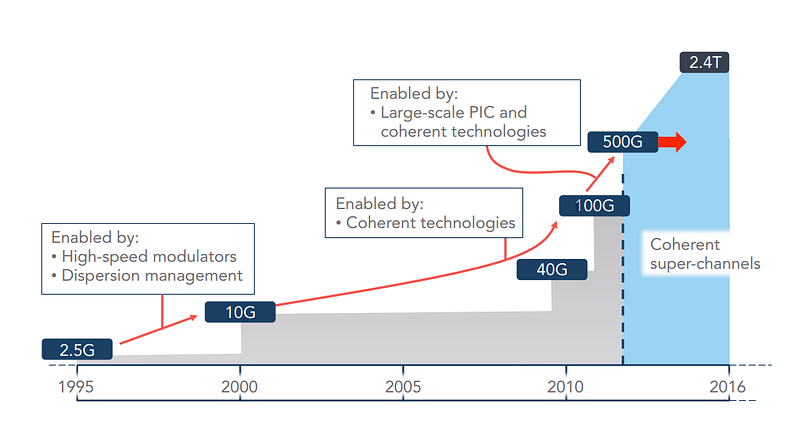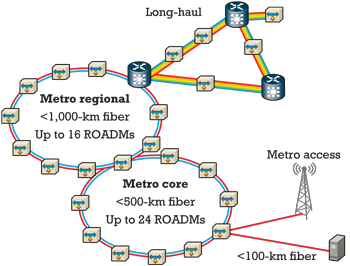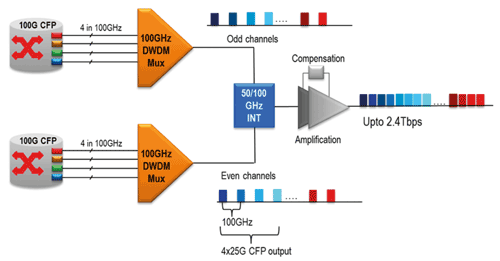Due to the rapid increase of communication traffic, the requirement for core networks to handle larger capacity and longer distance on their links has led to a spread of 100G optical networks. For this environment, service providers are adopting coherent transceivers for their 100G DWDM backbone applications. Until recently, coherent CFP/CFP2 DWDM optical transceivers had been the technology of choice for transporting 100G traffic over long distances or as part of a DWDM network. This paper will mainly discuss 100G coherent CFP module for metro network application.
Coherent Technology: Making 100Gb/s Available
Moving from 10Gb/s to 100Gb/s line speeds comes with technical challenges. Coherent technology had been investigated for optical transmission since the 1980s as a means to increase transmission distances. By 2010 to 2011, the technology had reached a point of market maturity. At this time, it could genuinely allow 100G coherent signals. This result forms the foundation of the industry’s drive to achieve transport speeds of 100G and beyond, which helps to deliver Terabits of information across a single fiber pair at a lower cost. Until now, coherent technology has been mainly deployed in long-haul networks, and it is now starting to be deployed in metro networks.
Figure 1: Capacity Enabled by Coherent Technology

Metro Requirements for 100G
100G rates were initially deployed in the long-haul and core networks. In the Metro, 10G is still the most dominant rate. In the coming years, the trend toward aggregation into 100G in the larger metro areas or data center connectivity will become more significant. The metro covers a broad range of distances: the metro regional and metro core cover distances of 500–1000 km and 100–500 km respectively, while the metro access links are generally point-to-point connections shorter than 100 km. Although these distances are shorter than long-haul links, the characteristics of metro network- including flexible protocol support, higher granularity of signal rates and increased number of nodes- create the requirements for 100G rates.
Figure 2: Three Types of Metro Network

100G Coherent CFP Module for Metro Network Applications
While metro and long haul applications have different requirements, the lower-cost 100G technology for the metro is demanded for service providers. To achieve this feat, equipment vendors consider coherent CFP modules as the ultimate solutions for metro 100G deployments. Coherent 100G CFP can overcome optical transmission impairments and still achieve acceptable performance.
Scenario 1: 100G Multi-Channel DWDM Networking

As shown in Figure 3, since the 100G rates are more susceptible to dispersion, they would require extra dispersion compensation and optical power boost. Thus an extra 100GHz DWDM multiplexer is first used to combine all the 100G rates together followed by a combined dispersion compensation and amplification stage. This architecture conveniently supports the ‘pay-as-you-grow’ model for service providers. When the bandwidth is exhausted, the existing legacy 10G channels may be seamlessly interchanged with 100G services. The same remaining components can even be reused to extend the data rate up to 2.4 Tb/s.
This scenario would require 24 differently colored CFP modules deployed together with the already existing 48 channel 100 GHz DWDM multiplexer. All the 100G services are first multiplexed together such that only one dispersion compensation and amplification stage suffices. Clearly, such a network architecture provides higher density with capability to reuse existing infrastructure with flexibility while remaining cost friendly.
Scenario 2: 100G Distance Extension Solutions
Figure 4: 100G Coherent DWDM Transport by Using SFP+ OEO Transponder

In this scenario, the switch was tested with SFP+ OEO transponders for simple distance extension solutions. The 100G output signals from the switch are converted to DWDM signals that can be transmitted over longer distance. The solution removes the distance limitations by using a coherent CFP module to connect the output signal to the line fiber and carry the signal over longer distances.
As shown in Figure 4, to achieve higher cabling density with Cisco CFP 100G optics, the architecture mixed a 16 channels dual fiber DWDM Mux Demux which can be used for CWDM/DWDM hybrid and 8 channels dual fiber CWDM Mux Demux, by adding MTP harness cable and WDM SFP+ OEO converter to transfer the regular SR wavelength to DWDM wavelengths. Therefore, building a long distance 2500km DWDM networks in 100G coherent CFP modules and cost effective way will be achieved.
Conclusion
100G coherent CFP modules provide cost-effective electronic equalization of fiber impairments and extensive performance monitoring capabilities that enable easy installation and network management. These benefits help service providers meet bandwidth demand growth while reducing the total cost of ownership.
If need OTN DWDM transmission system, welcome to contact our sales Ivy at sales6@htfuture.com



没有评论:
发表评论